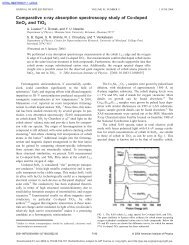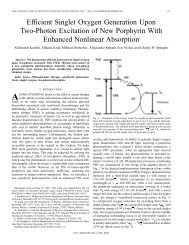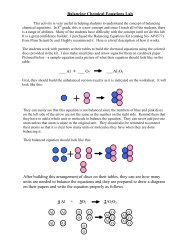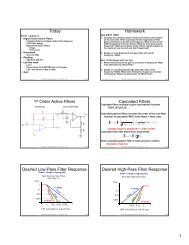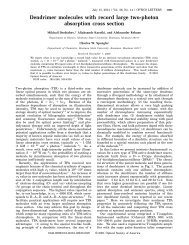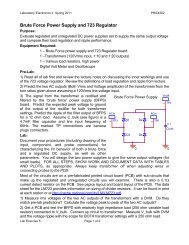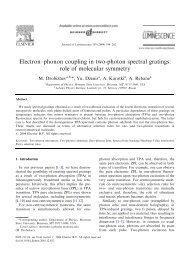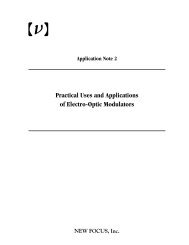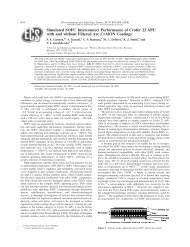Defects in inorganic photorefractive materials and their investigations
Defects in inorganic photorefractive materials and their investigations
Defects in inorganic photorefractive materials and their investigations
Create successful ePaper yourself
Turn your PDF publications into a flip-book with our unique Google optimized e-Paper software.
<strong>Defects</strong> <strong>in</strong> <strong>in</strong>organic <strong>photorefractive</strong> <strong>materials</strong> <strong>and</strong> <strong>their</strong> <strong>in</strong>vestigations 31<br />
Optical excitation across the b<strong>and</strong>gap (∼ 2.3 eVatroomtemperature,<br />
∼ 2.5 eV at 4.2 K) creates several paramagnetic defects <strong>in</strong> all specimens, <strong>in</strong>dependent<br />
of <strong>their</strong> dop<strong>in</strong>g. It is known [182] that such illum<strong>in</strong>ation leads to<br />
persistent conductivity; i.e. the electrons <strong>and</strong> holes created <strong>in</strong> this way are<br />
connected with such large lattice relaxations that the consequent vibrational<br />
overlaps between excited <strong>and</strong> ground state are strongly h<strong>in</strong>dered from recomb<strong>in</strong>ation.<br />
The extreme metastability of the optically excited state allows to<br />
study the hole <strong>and</strong> electron systems <strong>in</strong>dependently. All the identified paramagnetic<br />
defects are of hole type. The complicated monocl<strong>in</strong>ic crystal structure of<br />
SPS, where all ionic sites do not have any po<strong>in</strong>t symmetry except the identity,<br />
renders the def<strong>in</strong>ite assignment of the EPR signals rather difficult. The follow<strong>in</strong>g<br />
defect types have been identified at 10 K [95, 183]: 1) Two species with<br />
properties compatible with two slightly different Sn 3+ (5s 1 ) ions, Sn 3+<br />
1 <strong>and</strong><br />
; they are likely to be caused by hole self-trapp<strong>in</strong>g at the two crystallographically<br />
<strong>in</strong>equivalent Sn 2+ ions <strong>in</strong> the lattice. 2) S − ions probably result<strong>in</strong>g<br />
from hole self-trapp<strong>in</strong>g at the many different S 2− sites <strong>in</strong> the crystal. 3) Fe 3+ ,<br />
attributed to hole trapp<strong>in</strong>g at Fe 2+ background impurities at a low symmetry<br />
crystal site characteristic for SPS.<br />
So far one can only speculate why the excited electrons <strong>in</strong> or near the<br />
conduction b<strong>and</strong> are EPR-silent. S<strong>in</strong>ce the conduction b<strong>and</strong> has ma<strong>in</strong>ly Sn +<br />
character (5p 1 , sp<strong>in</strong> S =1/2), concluded from a rigid lattice b<strong>and</strong> calculation<br />
[184], an electron <strong>in</strong> such a state should lead to an EPR signal. S<strong>in</strong>ce the<br />
Sn ions are rather loosely bound <strong>in</strong> wide cages formed by the surround<strong>in</strong>g<br />
P 2 S 6 units, a conduction b<strong>and</strong> charge carrier can lower its energy by large<br />
lattice relaxation, i.e. it will form a polaron. Possibly each two of them pair<br />
diamagnetically to EPR-silent bipolarons. S<strong>in</strong>ce the mobility of bipolarons is<br />
much lower than that of s<strong>in</strong>gle polarons, this would add to the metastability<br />
of the excited state <strong>and</strong> the slow component [185] of the <strong>photorefractive</strong> effect.<br />
The excitation across the b<strong>and</strong>gap causes wide optical absorption b<strong>and</strong>s<br />
rang<strong>in</strong>g from ∼ 1 eV (or lower) up to the fundamental absorption with a maximum<br />
for most samples near 1.9 eV. These features are at least partly related<br />
to the above hole trapp<strong>in</strong>g defects. This is demonstrated <strong>in</strong> [185] with comb<strong>in</strong>ed<br />
EPR/optical absorption <strong>in</strong>vestigations of the light-<strong>in</strong>duced hole states.<br />
Sn 3+<br />
2<br />
7.2 Pb 5 Ge 3 O 11<br />
This material is known s<strong>in</strong>ce 1990 [186] as promis<strong>in</strong>g for <strong>photorefractive</strong> applications.<br />
Lead germanate crystals are ferroelectric with T c = 178 ◦ C <strong>and</strong> have<br />
trigonal symmetry. Two compet<strong>in</strong>g <strong>photorefractive</strong> grat<strong>in</strong>gs are found [187],<br />
a fast one with a build-up time of about 1 s <strong>and</strong> a slow one respond<strong>in</strong>g with<strong>in</strong><br />
m<strong>in</strong>utes to hours. There are <strong>in</strong>dications that the responsible defects are of<br />
<strong>in</strong>tr<strong>in</strong>sic type.<br />
Under b<strong>and</strong>gap (∼ 3.2 eV) illum<strong>in</strong>ation electrons <strong>and</strong> holes are formed<br />
[188]. As established from the analysis of the EPR data, the latter are trapped<br />
at one of the six <strong>in</strong>equivalent <strong>in</strong>tr<strong>in</strong>sic Pb 2+ sites of the lattice, form<strong>in</strong>g Pb 3+ ,





